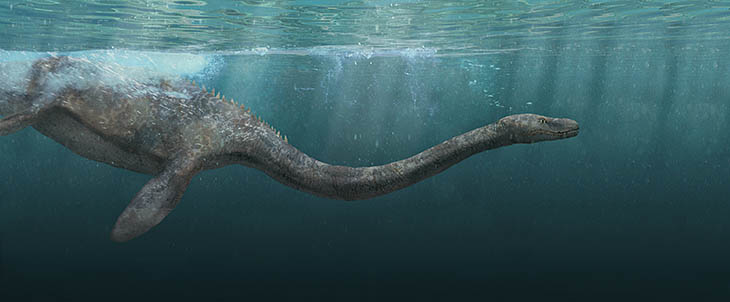This article was originally published in the defunct eSkeptic newsletter at Skeptic.com on June 13, 2007. An archived version is available here.
The Loch Ness Monster has hit the mainstream news media once again in a video shot by Gordon T. Holmes. Daniel Loxton takes a skeptical look at the video and provides his commentary. Daniel is the editor and illustrator of Junior Skeptic magazine and Skeptic magazine’s resident expert on cryptozoology.

Illustration by Daniel Loxton [later published inside Abominable Science!]
It’s strange what turns out to be newsworthy. As a rule, mainstream news media are all too happy to ignore such traditional skeptics topics as lake monsters; indeed, it is increasingly the case that the dedicated skeptics press has little interest in monsters and things that go bump in the night.
Yet, every once in a while, a cryptozoology story hits the mainstream press with a surprisingly big splash. This is certainly the case with new footage shot by one Gordon Holmes at Loch Ness, which is purported to show Nessie in action. This video of something-or-other on the water has garnered coverage from virtually all the major news providers of the English-speaking world (including CNN, CBS, FOX, BBC, ABC, NBC, MSNBC — even Forbes).
And yet, it’s a terrible video. In my considered opinion, it could easily be anything. Accordingly, a bewildering variety of explanations have been offered, from hoaxes (a large or mid-sized object towed by diving sled or cable; a small plastic motorized toy) to misinterpretations (birds, otters, beavers) to undiscovered species of several types (plesiosaurs, giant eels, extinct whales). This very abundance of conflicting hypotheses probably tells us all we need to know about the film: it is a kind of Rorschach test, reflecting the expectations of the viewer. As such, it is utterly useless as evidence for Nessie.
Yet, there is still more reason to keep the film at arm’s length. Commendably, cryptozoologist Loren Coleman took the time to do the obvious, running a preliminary background check on the film’s author, Gordon Holmes. As reported in Coleman’s blog, readily available web sources reveal Holmes as a man of multiple paranormal proclivities. Identified in mainstream headlines as an “amateur scientist,” Holmes is in fact a self-publisher of numerous fringe booklets linking megalithic art to cosmic forces. More to the point, Holmes claims to have had previous cryptozoological encounters, such as seeing a black panther stalking sheep in England. (This is an example of what cryptozoologists call an “ABC”, or Alien Big Cat, which is a large wild feline spotted far outside its known range).
Most damaging, Holmes claims that he has filmed fairies (“and strange Lady Figures”) at several locations — and he offers that fairy footage for sale.
Reason for caution? You bet. While it’s true that any genuine cryptid film might well come from “believers” (who have the motivation to attempt to capture such footage), the fact that Holmes has both a vested financial interest and personal dedication to the paranormal is definitely a red flag. As Coleman rather delicately put it, “Realistically, we must now admit, at the very least, Gordon T. Holmes is a bit eccentric, perhaps a shade too gullible, and if he still believes in the Cottingley Fairies photographs, which were promoted by Sir Arthur Conan Doyle, then he is not current on his reading.”
Which brings us back to the media furor: if the film is so bad, and its authorship so suspicious, why on Earth has it garnered global news attention? Frankly, that’s a good question. Part of the answer must be the star quality of Nessie herself. Viewers (and therefore advertisers, and therefore networks) care about the Loch Ness monster, so it is not surprising that new footage should draw some attention. Yet, this cannot be the whole explanation. Monster films are common — many of them vastly superior in quality to this one — yet few attract a fraction of this coverage.
Like other breakout cryptozoological hits (such as the Patterson / Gimlin film), this video combines two qualities that make it compelling: it is both life-like and indistinct. Whatever it is, it gives us a powerful impression of something alive. At the same time, the weakness of the video means our imaginations are free to impose any interpretation we prefer.
In the end, this newest film tells us nothing at all about Nessie. But it does carry a message for skeptics: like it or not, skepticism’s traditional paranormal topics are alive and well — and swimming in Loch Ness.